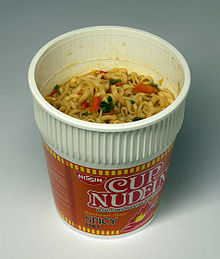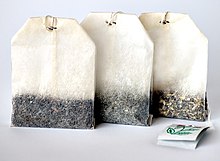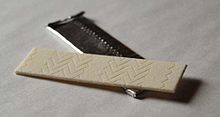Portion packaging

A portion packaging is a special type of prepackage in which the packaged goods (mostly food , food additives or drugs ) in a metered Portions volume is packed, which is the average delivered thoughtful consumption or the individual consumer or the seller offers special advantages.
Transparent packaging for small parts also counts as portion packs. In the broadest sense, a cigarette is also a portion pack for smoking tobacco . Even cutlery is in portion packaging for passenger flights and occasionally in the hospitality industry (with metal utensils if no table setting offered is presented).
history
Although baking powder was manufactured on a large scale from 1854, its success story did not begin until 1898 with August Oetker , who further developed the recipe and marketed the product in small portions for housewives for baking cakes instead of to bakers for baking bread as was previously the case. As a result, vanilla sugar , pudding powder and dry yeast were also marketed in individual portions.
Around 1880 began Liebig's Extract of Meat Company , bouillon cubes manufactured and packed individually.
In 1893, William Wrigley Jr. into chewing gum production, his product Wrigley's Juicy Fruit became the most popular type of chewing gum in America thanks to its unconventional advertising methods.
In 1904 or 1908 the tea bag was invented; However, it only became popular as an infusion bag from Teekanne GmbH from 1929 .
Around 1920 the food distributors began Karl Hellmann , sugar cubes to in two packages as a side dish hot drinks market, and later sugar portions of granulated sugar (annual production in 2012 of 1.3 billion pieces). As a result, spreads (butter, margarine, jam , honey, etc.), sweeteners, bread, crispbread and rusks were filled into portion packs.
1989 was the machine dishwashing detergent Somat first sold as a compressed tablet. Today around 25 million dishwashers are in use in Germany. Dishwasher tabs have now taken the dominant position over classic powder with a share of 87% (as of 02/2008).
In more recent times, coffee pods and the associated portion coffee machines have become more popular instead of filter coffee preparation.
Medicines or finished medicinal products are often packed in blister packs.
advantages
Benefits for consumers
Portion packs of food offer the consumer the advantage of not having to measure the required amount. A little baking powder, for example, is enough for a standard amount of cake, or the recipes are tailored to this. The food (e.g. coffee milk) can be consumed in single portions without any residue spoiling.
Benefits for providers
- Transparent packaging allows the sale of small parts in self-service shops in standardized quantities, visually verifiable and already provided with a barcode ( picking , price labeling and counting sales staff are no longer required, costs are saved)
- Tea bags made of fine filter materials also make it possible to market tea dust, which is otherwise a waste product in tea production
Benefits in the hospitality industry
- Portion packs can lead to an under-consumption of the product
- Extras for the guest are easier to calculate,
- Portion packs (from sugar cubes to shower gel), like other merchandising products (such as bathrobes, umbrellas, golf balls), can have the name of the company printed on them, making them an advertising medium.
disadvantage
Waste problem
Individual packaging is seen as unnecessary garbage.
Disadvantages from the point of view of environmental protection are the high amount of packaging waste in transparent packaging , especially small objects, and the poorer ecological balance of plastic compared to cardboard . Blisters are therefore controversial. Another disadvantage is that the packaging usually becomes unusable after first opening. Furthermore, the opening of blister packs made entirely of plastic is sometimes extremely difficult, since the front and back are usually welded together and it is very difficult to open them cleanly and easily without tools. In addition, carelessness when opening the blister can lead to injuries on cut edges.
Manufacturer
literature
- Dr. August Oetker KG (Ed.): Dr. Oetker consumer goods . 8th edition. Ceres-Verlag Rudolf-August Oetker KG, Bielefeld 1961, p. 529, IDN 455375232.
Individual evidence
- ↑ Website ( Memento of the original from November 26, 2012 in the Internet Archive ) Info: The archive link was inserted automatically and not yet checked. Please check the original and archive link according to the instructions and then remove this notice. from Hellma.
- ↑ Henkel: Somat ( Memento of the original from July 25, 2015 in the Internet Archive ) Info: The archive link was inserted automatically and has not yet been checked. Please check the original and archive link according to the instructions and then remove this notice. (History), company website.
- ↑ Stiftung Warentest: Test Dishwasher Tabs test 02/2008, p. 66 (accessed online on February 4, 2013).
- ^ Karl Heinz Hässler: Management in the Hotel Industry and Gastronomy - Business Basics , 8th Edition, Oldenbourg-Verlag, ISBN 978-3-486-70448-8 , page 218.
- ↑ Stiftung Warentest: waste package , accessed on February 4, 2013.
- ↑ Waste avoidance rules , PDF file, accessed on January 5, 2012.
- ↑ European Waste Prevention Week: Tips and Actions .
- ↑ Waste and Disposal , website of the Swiss municipality of Riehen-Bettlingen.
- ↑ Celebrations, reducing waste , Green League Network of Ecological Movements, Landesverband Berlin eV


